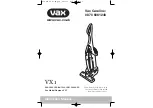
22
| English
1 609 92A 4M0 | (16.11.2018)
Bosch Power Tools
Wet vacuuming
u
Do not use the vacuum cleaner to vacuum combustible
or explosive liquids, such as petrol, oil, alcohol or
solvents. Do not vacuum hot or burning dust. Do not
operate the vacuum cleaner in areas subject to explo-
sion hazards.
Dust, vapours and liquids can ignite or ex-
plode.
u
The vacuum cleaner must not be used as a water
pump.
The vacuum cleaner is designed for vacuuming air
and vacuuming water mixtures.
Note:
The requirements for the degree of penetration (dust
class L) have only been verified for dry vacuuming.
Steps to Take before Wet Vacuuming
– Remove the disposal bag
(23)
or dust bag if necessary.
Note:
Use a wet filter bag (accessory), which separates li-
quid from solids, to make disposal easier when vacuuming
water-solid mixtures.
– Place the rubber lip
(26)
in the floor nozzle
(28)
. (see
"Fitting the rubber lip (wet vacuuming) (see figure
E
)",
page 21)
– Switch off the automatic filter cleaning (AFC). (see "Auto-
matic filter cleaning (see figure
H
)", page 22)
Vacuuming up liquids
– To
switch on
the dust extractor, set the mode selector
switch
(6)
to the "extraction" symbol.
The dust extractor is equipped with fill level sensors
(35)
.
The dust extractor shuts down if the maximum fill level has
been reached. Set the mode selector switch
(6)
to the
"switch off" symbol.
Note:
When extracting non-conductive liquids (e.g. drilling
emulsion, oils and fats), the dust extractor will not switch off
when the container is full. The fill level must be constantly
monitored and the container emptied in good time.
– To
switch off
the dust extractor, set the mode selector
switch
(6)
to the "switch off" symbol.
– Empty the container
(1)
.
To prevent mould growth after wet vacuuming:
– Remove the flat-pleated filter
(24)
and leave this to dry
thoroughly.
– Remove the top part of the dust extractor
(10)
, open the
filter cover
(34)
and leave both elements to dry thor-
oughly.
Automatic filter cleaning (see figure H)
When automatic filter cleaning (AFC) is active, the flat-
pleated filter
(24)
is cleaned every 15 seconds using blasts
of air (pulsating noise).
The filter cleaning function should be used regularly, and at
the very latest when the suction power is no longer suffi-
cient.
Regular use of the filter cleaning function will increase the
service life of the filter.
In order to achieve an optimum filter service life, deactivate
the automatic filter cleaning function only in exceptional
cases, e.g. when vacuuming pure liquids or using a paper fil-
ter bag.
A flat-pleated filter with surface dirt is still fully functional. It
is not necessary to clean the flat-pleated filter manually by
shaking or blowing it out; this may even damage the filter.
Note:
The automatic filter cleaning function is switched on
by default when the dust extractor leaves the factory.
It is only possible to switch the automatic filter function on or
off when the tool is switched on.
–
Deactivating AFC
Press the AFC button
(3)
.
The control LED
(33)
will go out.
–
Activating AFC
Press the AFC button
(3)
.
The control LED
(33)
will light up green.
Maintenance and Service
Maintenance and cleaning
u
Pull the plug out of the socket before cleaning or per-
forming maintenance on the vacuum cleaner, making
tool adjustments, changing accessories or putting
away the vacuum cleaner.
This safety measure prevents
the vacuum cleaner from being started accidentally.
u
To ensure safe and efficient operation, always keep
the dust extractor and the ventilation slots clean.
u
Wear a dust mask when servicing and cleaning the va-
cuum cleaner.
In order to avoid safety hazards, if the power supply cord
needs to be replaced, this must be done by
Bosch
or by an
after-sales service centre that is authorised to repair
Bosch
power tools.
For the user to carry out maintenance, the vacuum cleaner
needs to be disassembled, cleaned and maintained as far as
this is possible without endangering maintenance personnel
or other persons. Before disassembly, the vacuum cleaner
should be cleaned to prevent any potential hazards. The
room in which the vacuum cleaner is disassembled should
be well ventilated. Wear personal protective equipment
while carrying out maintenance. After completing mainten-
ance, the maintenance area should be cleaned.
An inspection regarding the dust extraction capability must
be carried out at least once a year by the manufacturer or
someone who has been trained, e.g. to check for filter dam-
age, that the vacuum cleaner is tight and that the control unit
is functioning correctly.
Class
L
vacuum cleaners which were located in dirty environ-
ments should have their exteriors, as well as all their com-
ponents, cleaned or treated with sealant. When performing
maintenance and repair work, all dirty parts that cannot be
cleaned satisfactorily must be disposed of. Such parts must
be disposed of in impermeable bags in accordance with the
valid provisions for disposing of such waste.
















































